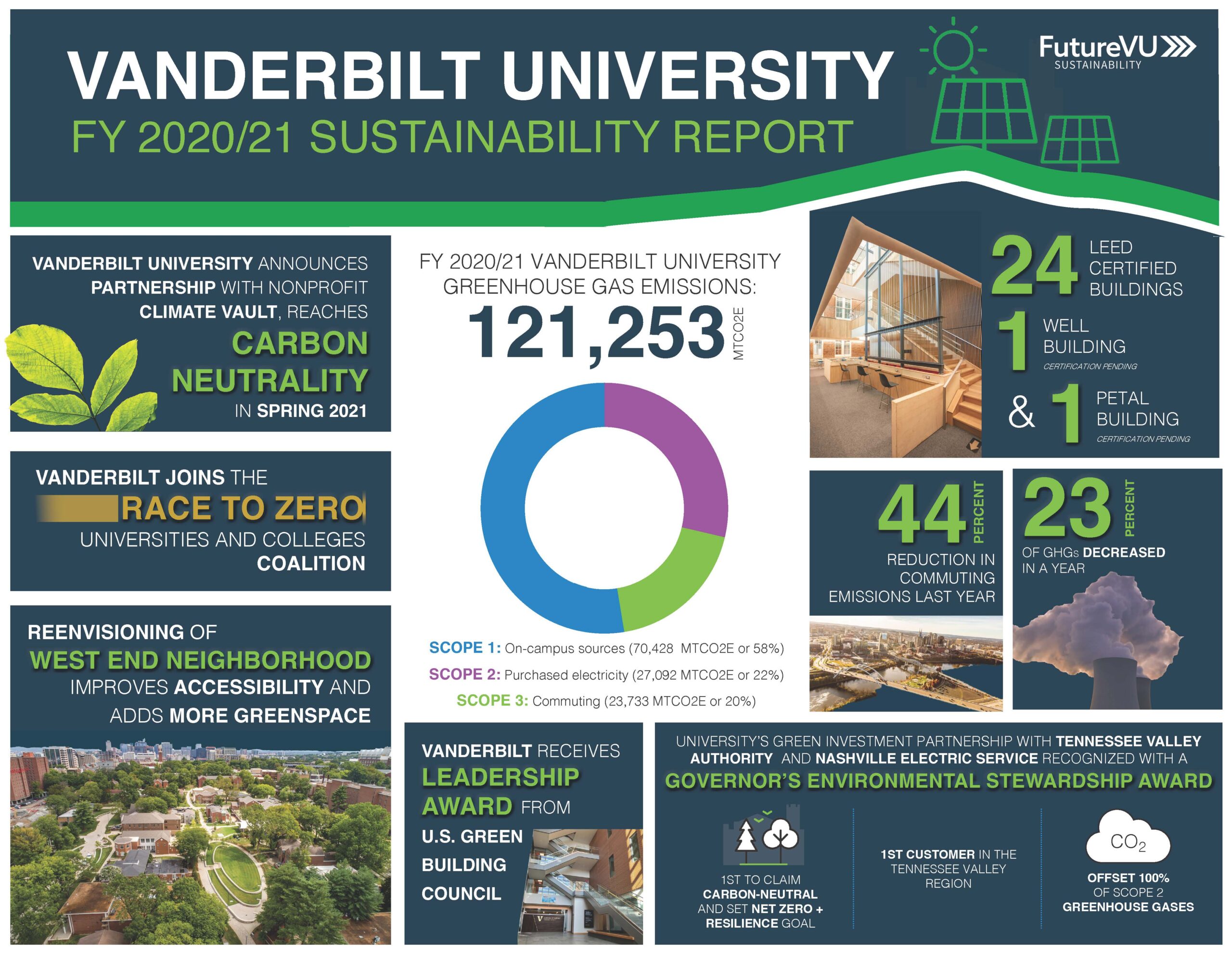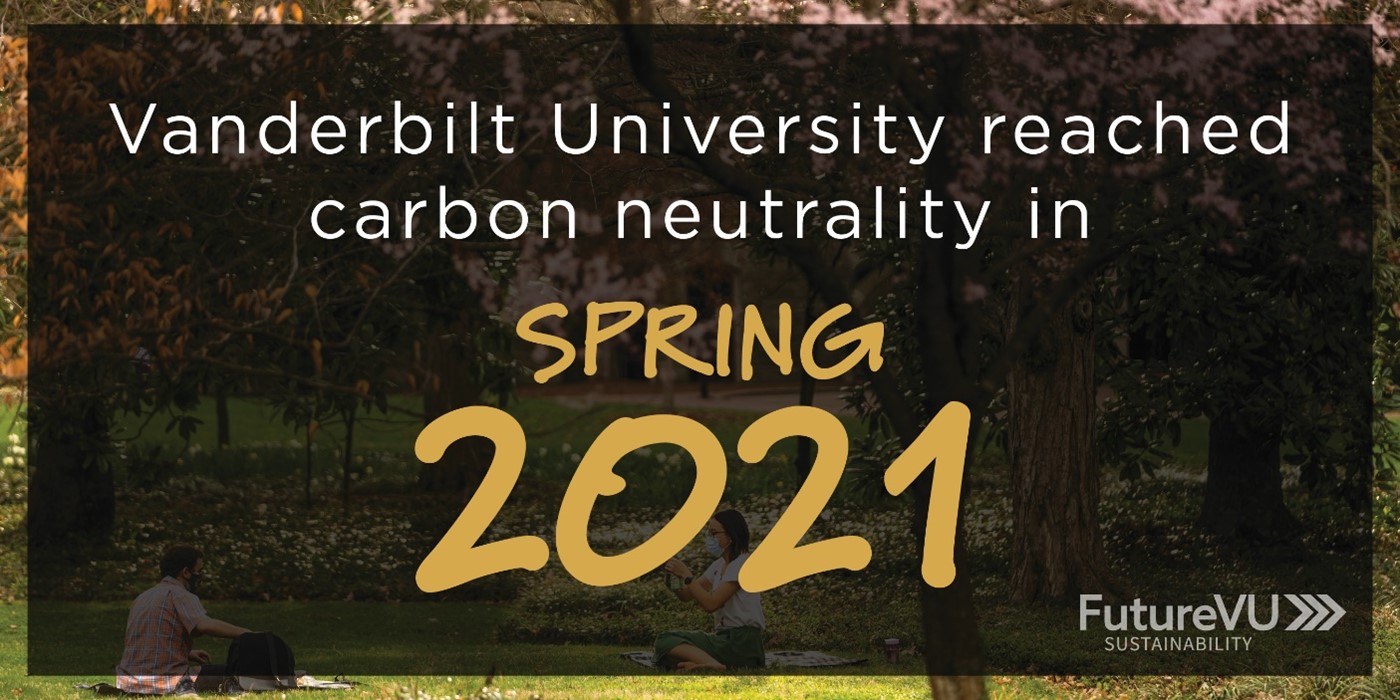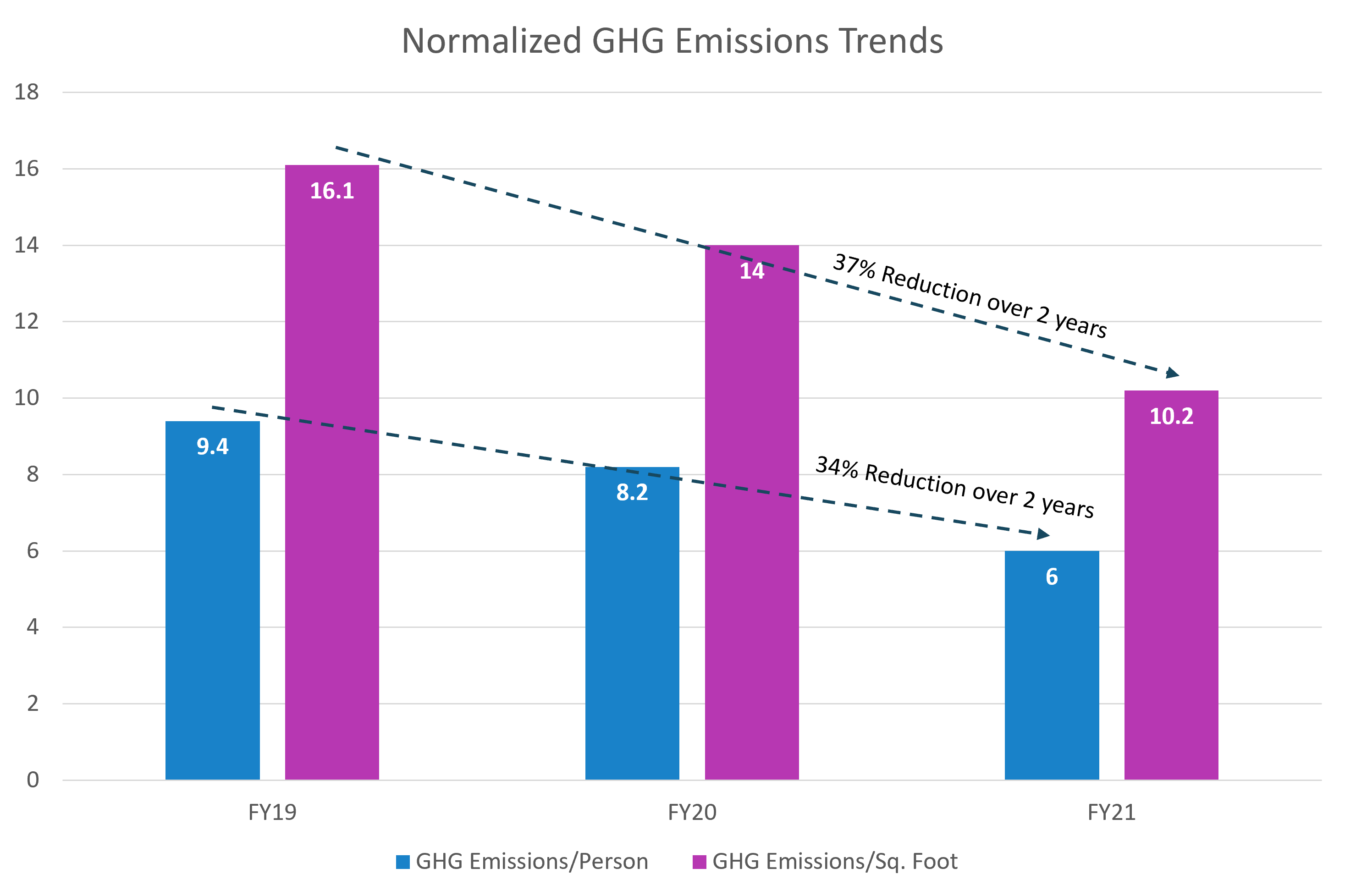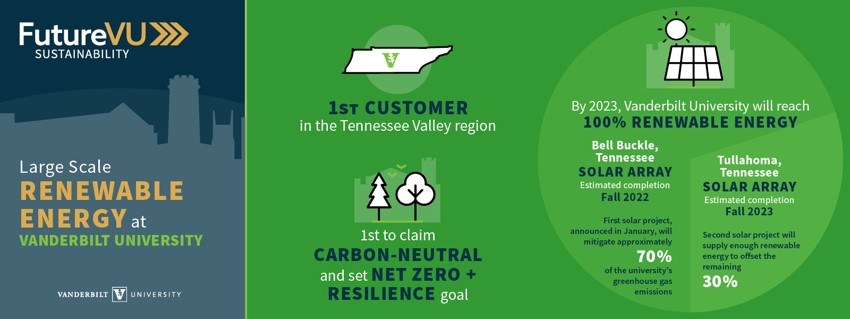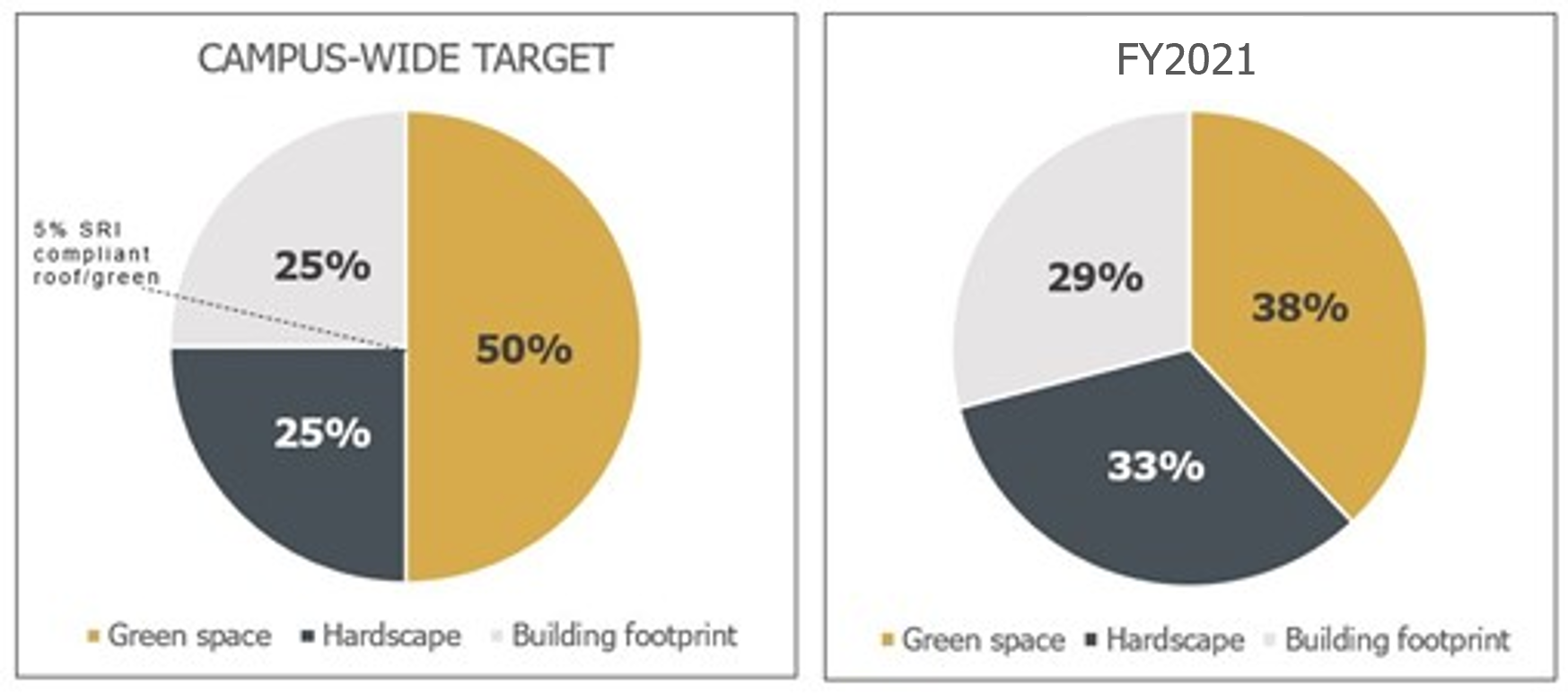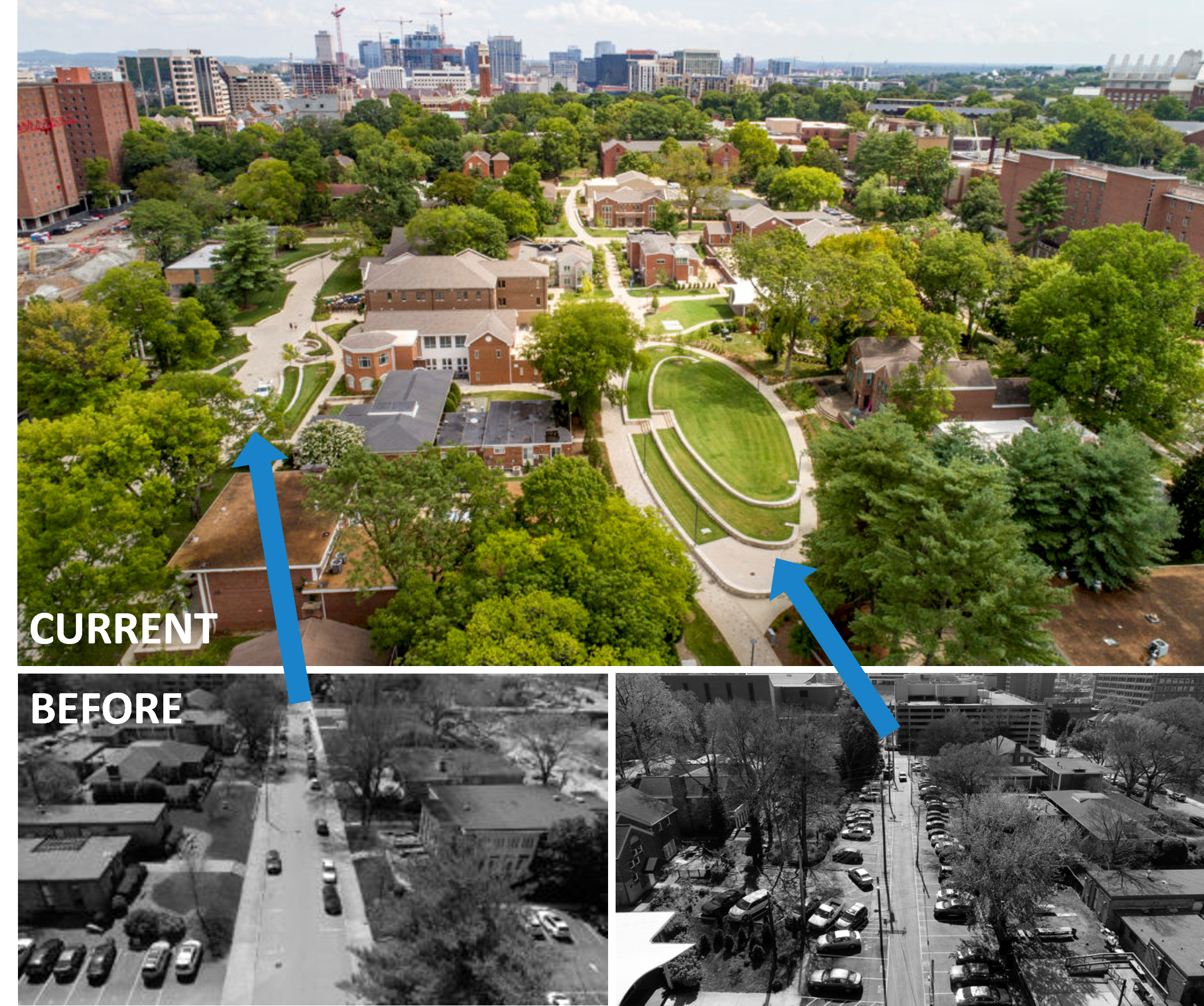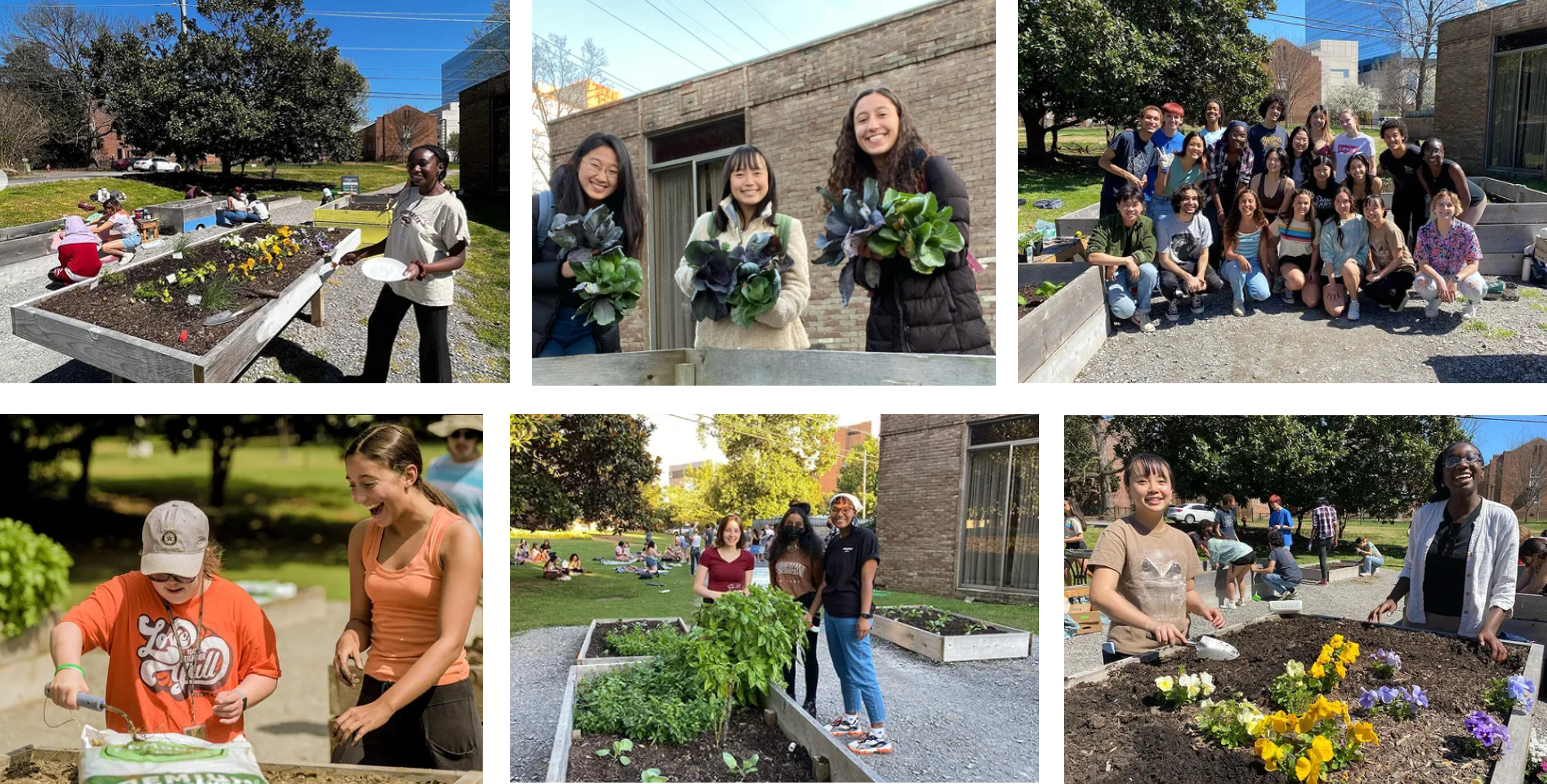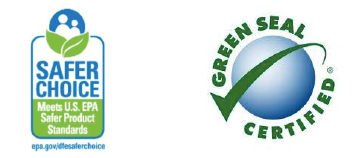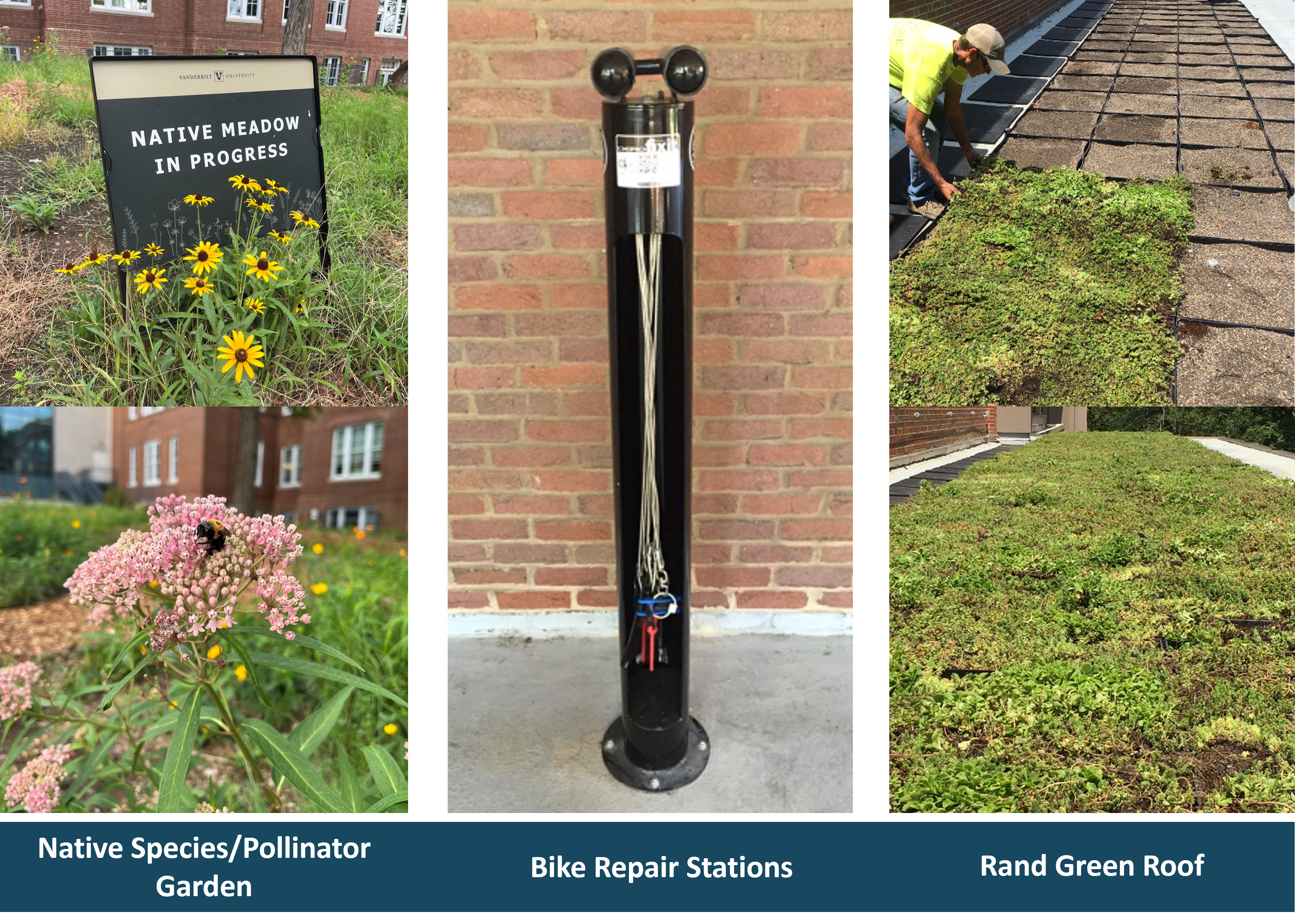Annual Sustainability Report FY 2020-2021
Introduction
A $1 million gift from Commodore Cornelius Vanderbilt in 1873 established the University following the Civil War, with the mission to “contribute to strengthening the ties which should exist between all sections of our common country.” Today, Vanderbilt University is a top-15 private research university offering a full-range of undergraduate, graduate, and professional degrees. Vanderbilt is situated on a 340-acre campus near the thriving city center of Nashville, TN, serving over 13,000 students and directly employing over 6,000 faculty and staff. Its affiliated academic medical center, Vanderbilt University Medical Center (VUMC), is contiguously located and operates in close partnership and through a combined internal power grid with the University.
Vanderbilt University operates an on-site, natural gas fueled co-generation power plant that meets the steam and a portion of the chilled water needs of the University and Medical Center and 29% of the electrical needs. The remaining 71% electrical need is purchased from the Tennessee Valley Authority through Nashville Electric Service (NES). Vanderbilt emits Greenhouse Gases (GHGs) through these two processes as well as university fleet vehicle use, refrigerant releases, faculty, and staff commuting to work, air travel paid for by the University, and waste disposal and recycling.
The six GHGs emitted into the atmosphere that comprise the majority of the carbon footprint are: carbon dioxide (CO2); methane (CH4); nitrous oxide (N2O); hydrofluorocarbons (HFCs); perfluorocarbons (PFCs); and sulfur hexafluoride (SF6). The amount of emissions of each gas are converted to a standard unit of measure, or metric tons of carbon dioxide equivalents (MTCO2E) and then summed to determine Vanderbilt’s carbon footprint.
Vanderbilt University embarked on a new journey as an independent legal entity from VUMC on May 1, 2016. Vanderbilt University is now smaller in both number of people and square feet without the Medical Center, and therefore, so are the 2016 and forward Greenhouse Gas inventories in comparison to previous inventories (2005-2015). Because of the significant shift in GHG footprint due to the new organization, 2005-2015 GHG data is archived. The 2016 Annual Report contains first year baseline data for the University only, with the 2021 Annual Report presenting the fifth year of trending data. This sustainability report is intended to portray Vanderbilt’s current carbon footprint as accurately as possible and to highlight other key sustainability gains in fiscal year 2021 from July 2020-June 2021, aligning with the Vanderbilt academic year cycle.
Campus operations were shifted moderately for respond to the COVID-19 pandemic during FY20-21. Significant parts of the university operated under hybrid remote/in-person work during this time and campus buildings were ramped-down to match reduced campus occupancies. As a result, commuting and air travel emissions were significantly lower to reflect those modifications.
This report is developed by the Vanderbilt Sustainability and Environmental Management Office (SEMO). Any questions should be directed to futurevusustainability@vanderbilt.edu.
Carbon Footprint
OUR GOAL
On Earth Day 2019, Vanderbilt University unveiled a comprehensive long-term strategy to significantly reduce its environmental footprint in part by powering its campus entirely through renewable energy, putting the university on track to be carbon neutral by 2050.
In 2021, Vanderbilt University announced a new collaboration with the nonprofit organization Climate Vault that allows the university to address the full extent of its carbon footprint now, achieving carbon neutrality decades ahead of its initial goal. The new initiative will effectively remove carbon pollution permits from regulated carbon markets while simultaneously stimulating research into emerging carbon removal technologies. Several large efforts are already underway to make significant strides toward reducing Vanderbilt’s emissions. While the university continues to push action and innovations on several fronts, it has identified a near-term opportunity to work with Climate Vault and use the cap-and-trade market—which is designed to limit harmful emissions—to accelerate its impact, allowing it to become the first member of the Association of American Universities to achieve carbon neutrality.
GHG EMISSION SOURCES
Vanderbilt reports greenhouse gas (GHG) emissions across all major sources.
Scope 1: The most significant source of Scope 1 emissions is natural gas use at the on-campus power plant and in individual buildings. Additional Scope 1 emissions include fleet vehicles, diesel use at the power plant, emergency generators, anesthetic gas use, and refrigerant releases.
Scope 2: Scope 2 emissions are entirely from electricity purchased from Nashville Electric Service (NES).
Scope 3: Scope 3 emissions at Vanderbilt include faculty, staff, and student commuting, air travel, waste disposal, and recycling.
More information related to Scope 1 and 2 emissions can be found in the Energy section of this report. Details related to Scope 3 emissions can be found in the Transportation and Waste sections of this report.
GHG EMISSION SCOPES
Vanderbilt University emitted 121,253 metric tons of carbon dioxide equivalents (MTCO2E) in FY20-21. These greenhouse gas emissions were split between Scopes 1, 2, and 3 – 58%, 22%, and 20%, respectively. Scope 1 emissions are direct emissions from sources that are controlled by Vanderbilt, such as combustion of natural gas in the on-campus power plant. Scope 2 emissions are indirect emissions from purchased electricity. Scope 3 emissions are not directly controlled by Vanderbilt but are associated with Vanderbilt, such as employee commuting, air travel, and waste disposal.
Compared to the FY19-20 Greenhouse Gas (GHG) emissions footprint calculation, FY20-21 footprint shows an overall decrease of 23% metric tons of CO2 equivalent (MTCO2E). VU’s GHG emissions per gross square foot has dropped by 27% since the previous fiscal year, and 37% over two years, despite a growth of 800,000 square feet over the same period.
INVEST IN ON-SITE CLEAN ENERGY
BlueSky Vision Energy Strategy Study
The BlueSky Energy Vision was completed in 2018 with the publication of the BlueSky Energy Vision Report. The report identifies major potential opportunities to reduce Vanderbilt’s carbon footprint and improve central campus land use within the University’s on-campus energy production, distribution and consumption infrastructure and behavior. This culminated in a “BlueSky Vision” for campus energy in 2019, detailed below.
Vanderbilt, by the year 2050, will achieve Net Zero Energy with Resiliency by: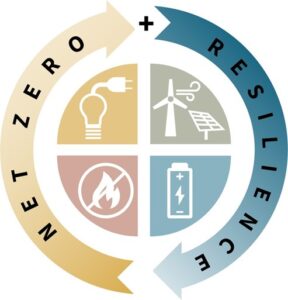
- being a leader in energy conservation
- producing on-site clean (without combustion) and renewable energy
- procuring off-site renewable energy to mitigate campus greenhouse gas emissions
- storing sufficient clean energy to provide campus resilience
ON-SITE SOLAR
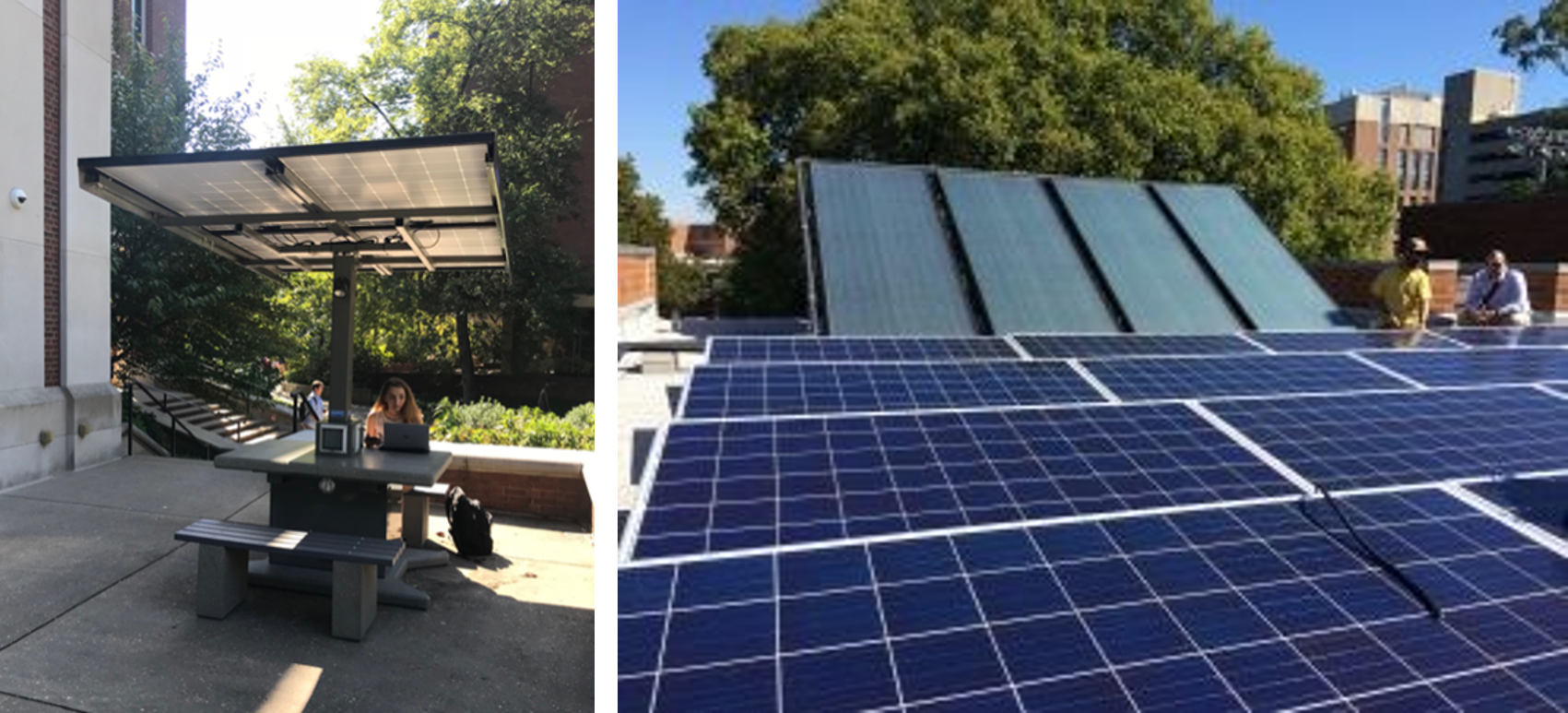 A solar-powered hot water heating system is installed in the Currey Tennis Center. Solar panels installed on the roof collect the sun’s energy to heat the water for the building. A 20kW solar panel system is also installed on the roof of Currey Tennis Center. The solar panels generate electricity from the sun’s energy, which is fed into the Vanderbilt electricity grid. A dashboard of the solar panel system can be viewed online with the login: sustainvu@vanderbilt.edu and password: VU*Tennis.
A solar-powered hot water heating system is installed in the Currey Tennis Center. Solar panels installed on the roof collect the sun’s energy to heat the water for the building. A 20kW solar panel system is also installed on the roof of Currey Tennis Center. The solar panels generate electricity from the sun’s energy, which is fed into the Vanderbilt electricity grid. A dashboard of the solar panel system can be viewed online with the login: sustainvu@vanderbilt.edu and password: VU*Tennis.
Campus also hosts four solar picnic tables. Each table features a solar array, LED nighttime lighting, four 120 volt and eight USB charging stations, and two large benches for students. The systems will be able to provide 75-100 iPhone charges per day. The tables are installed outside of Kissam Center, Highland Quad, and two at the Commons Center.
Invest in off-site large-scale renewable energy
Large-Scale Renewable Energy Study
The Large-Scale Renewable Energy Study, conducted with input from the Large-Scale Renewable Energy Study Advisory Committee, a mix of diverse stakeholders on campus, explored potential options for off-campus, large-scale renewable energy sources, including solar and/or wind projects.
Following the BlueSky Energy Vision Study and the Large-Scale Renewable Energy Study, in FY19-20, Vanderbilt entered into a pioneering agreement with the Tennessee Valley Authority and Nashville Electric Service to procure off-site large-scale renewable energy to help mitigate the campus’ greenhouse gas emissions. The 20-year Green Invest Program agreement will support Vanderbilt’s goal to power its campus entirely through renewable energy. The renewable power will come from two solar farms to be built in Bedford County and Tullahoma, Tennessee, by Nashville-based Silicon Ranch Corporation, the U.S. solar platform for Shell and one of the largest independent solar power producers in the country.
Through this agreement, Vanderbilt will reach its renewable energy goal just over four years after the university made its initial commitment in 2019. Vanderbilt’s initial partnership, announced in January 2020, will mitigate approximately 70 percent of the university’s indirect greenhouse gas emissions by fall 2022. The second Green Invest project will supply enough renewable energy to offset by fall 2023 the remaining 30 percent of the university’s annual indirect greenhouse gas emissions from purchased electricity. The agreement is also anticipated to provide hundreds of new jobs during the construction of the solar project as well as unique educational and research opportunities for the Vanderbilt community with both solar farm locations within close proximity to the Nashville area.
Vanderbilt University’s Green Invest Program partnership with the Tennessee Valley Authority and Nashville Electric Service has been recognized with a 2021 Governor’s Environmental Stewardship Award. The annual honors are considered the most prestigious environmental and conservation awards in Tennessee and support the governor’s priorities of job and economic development and health and welfare while also supporting TDEC’s priorities of public-private partnerships and positive environmental outcomes.
Decrease carbon footprint from vehicles
EMISSIONS SUMMARY
Vanderbilt is a major employer in Nashville. The university consists of close to 6,000 faculty and staff, is home to more than 7,000 undergraduate students, and is the place of study for an additional 6,500 graduate and professional students. Due to a transition to more remote work, Vanderbilt’s regularly commuting population shrank to about 4,600 people, compared to about 12,000 last year. In addition to the changes in commuting patterns, air travel during FY20-21 was significantly reduced from previous years. Commuting emissions contribute 20,038 MTCO2E to the University’s carbon footprint, down 44% from last year, while Air travel for faculty and staff accounts for another 421 MTCO2E, down 96% from last year. Transportation emissions are 17% of Vanderbilt’s overall emissions.
MOVEVU
MoveVU is Vanderbilt’s strategic transportation and mobility plan that falls under the FutureVU comprehensive campus planning efforts. MoveVU goals align with FutureVU guiding principles to beautify the campus, preserve and enhance the park-like character people enjoy, create a walkable and sustainable campus and better connect areas of campus that feel disconnected. MoveVU calls for diversification of transportation options, reduction of the drive alone rate to campus that aligns with university goals to become carbon neutral, prioritization of pedestrian and micromobility, and improvement of accessibility. The MoveVU plan outlines ways the university can shift its mode share and reduce the drive alone rate to campus. Vanderbilt University’s current drive alone rate is around 76.5%, and the MoveVU goal is to reduce the drive alone rate to 55% by 2025. In order to achieve this goal, the percentage of individuals taking alternative commute modes, such as walking, biking, taking transit, carpooling, vanpooling, and more, will need to increase.
In 2020, Vanderbilt explored a daily parking pilot program for a limited number of commuters. In 2021, the program was formalized and expanded to approximately 1,600 participants. The daily parking pilot gives commuters more options to choose from when making their daily decision on how they will travel to campus and provide greater flexibility than the traditional annual permit to better match their dynamic lifestyles. New this year, individuals enrolled in the daily parking program who take sustainable commutes to campus will earn a $0.50 daily incentive each time they choose a sustainable commute up to a total of $10 per month, assuming a 20-day work month. Eligible sustainable commutes include walking, biking, transit, carpooling and vanpooling. Vanpool and Carpool trips are also financially incentivized through the MoveVU Commute Hub. Vanderbilt will conduct a new commute survey in the Fall of 2022 to recalibrate the future mode share goals in response to commuting behavior changes related to COVID-19.
INCREASE GREEN SPACES ACROSS CAMPUS
A guiding principle of FutureVU is that Vanderbilt resides in a unique and distinctive park-like setting. The plan looks to balance the distribution of open lawns throughout campus through careful evaluation of built and open space targets. The FutureVU framework calls for an overarching campus-wide target of 50% green space, 25% hardscape and 25% building footprint. As of the end of FY20-21, the current campus breakdown is 38% green space, 33% hardscape and 29% building footprint.
To achieve this expansion of green spaces across campus, Vanderbilt has a variety of initiatives underway, including the expansion of a greenway network, the community garden, stormwater management practices, a landscape master plan, stormwater management practices, and green roofs, detailed below.
West End Neighborhood
Once covered with asphalt and concrete, the newly transformed Green and Kensington Promenade now feature pedestrian- and bike-friendly pathways, creating a welcoming environment for the Vanderbilt community. As part of Vanderbilt’s Academic Strategic Plan and in alignment with the FutureVU initiative, the project aims to create a more park-like setting in the West End Neighborhood while respecting Vanderbilt’s historic identity. Improvements to the West End Neighborhood have included creating pedestrian- and bicycle-friendly paths along former Kensington Place and 24th Avenue South, placing electrical and communication lines underground and adding Greek houses and a multi-purpose building. The neighborhood also now has more green spaces.
community garden
The Vanderbilt Community Garden was transitioned to a new more central location on campus in FY19-20. The new community garden continues to use the efforts of the Vanderbilt Community Garden student group with support from the Campus Dining and Facilities groups. The garden will include more than just plants and produce, it acts as a testing ground for sustainable gardening methods. The garden is available for use by the broader Vanderbilt community, as well as creating strong ties to the Vanderbilt Children and Family Center who will use the garden as part of their curriculum. Students Promoting Environmental Awareness and Responsibility (SPEAR) currently manages the garden.
stormwater management/smart irrigation
 Stormwater management practices are in place across campus. Nicholas S. Zeppos College collects and reuses rainwater from the roof to flush toilets. The Engineering Science Building has a cistern that collects stormwater from the roof for irrigation and includes a landscape with bioswales and a green roof to retain stormwater on site. Many additional sites across campus include stormwater pollution prevention measures, including vegetated drainage swales utilizing native plants, reduction in the amount of impervious area (replaced by landscaping) and pervious pavement, and use of the RainBird IQ system which allows for on-demand, efficient water use.
Stormwater management practices are in place across campus. Nicholas S. Zeppos College collects and reuses rainwater from the roof to flush toilets. The Engineering Science Building has a cistern that collects stormwater from the roof for irrigation and includes a landscape with bioswales and a green roof to retain stormwater on site. Many additional sites across campus include stormwater pollution prevention measures, including vegetated drainage swales utilizing native plants, reduction in the amount of impervious area (replaced by landscaping) and pervious pavement, and use of the RainBird IQ system which allows for on-demand, efficient water use.
One of Vanderbilt’s most significant efforts to conserve potable water is the collection of water from underground utility tunnels, which is used to irrigate sports fields and lawns on campus. In addition, air conditioning condensation collection systems are now in the Commons Center and two of the Medical Research Buildings.
landscape strategic plan
The Landscape Strategic Plan was developed to ensure that campus landscapes support the FutureVU principle that Vanderbilt is a university that resides in a unique and distinctive park-like setting and seeks to strengthen and expand the university’s aesthetic character. The Landscape Master Plan also supports the FutureVU goal of increasing green space to 50% or more across campus. In support of this vision, the Landscape Strategic plan sets standards and governance for the campus outdoor spaces. This is accomplished by establishing long-term goals, maintenance standards, record keeping procedures, advisory committee, and targets for the university landscape.
GREEN ROOFS
Vanderbilt has six green roofs across campus, which provide multiple benefits including reduced energy use in buildings, reduced urban heat island effect, improved stormwater management, increased roof longevity, and improved aesthetics.
Many of the green roofs at Vanderbilt are “hidden in plain sight” and act as plazas or lawns. The newest green roof was installed as a part of a major renovation of Eskind Library. A group of students organized a green roof awareness event in 2017 that led participants through the green roofs across campus to highlight these unique features and share information about the benefits.

Reduce consumption and waste
Zero Waste study and plan
The Zero Waste Study and Master Plan were been developed in 2019 by the Zero Waste Advisory Committee to address the portion of Scope 3 emissions related to waste disposal and recycling and to help progress towards Vanderbilt’s carbon neutrality goal. Of Vanderbilt’s Scope 3 emissions, waste and recycling is responsible for 3,274 metric tons of CO2 equivalent (MTCO2E) or 3% of the total GHGs that Vanderbilt emitted in FY20-21.
Based on past data, the Committee recommended that the university should aim for the following two goals, along with two supporting actions:
GOAL 1: Zero waste (90 percent diversion from landfill) by 2030
GOAL 2: Reduce waste generated 30 percent by 2030
Supporting Actions:
- End institutional single-use plastic purchases by 2025, except in laboratories*; and
- Expand food waste collection to include all dining areas and residential halls by 2025
*Laboratories are exempt due to lack of available alternatives and safety concerns.
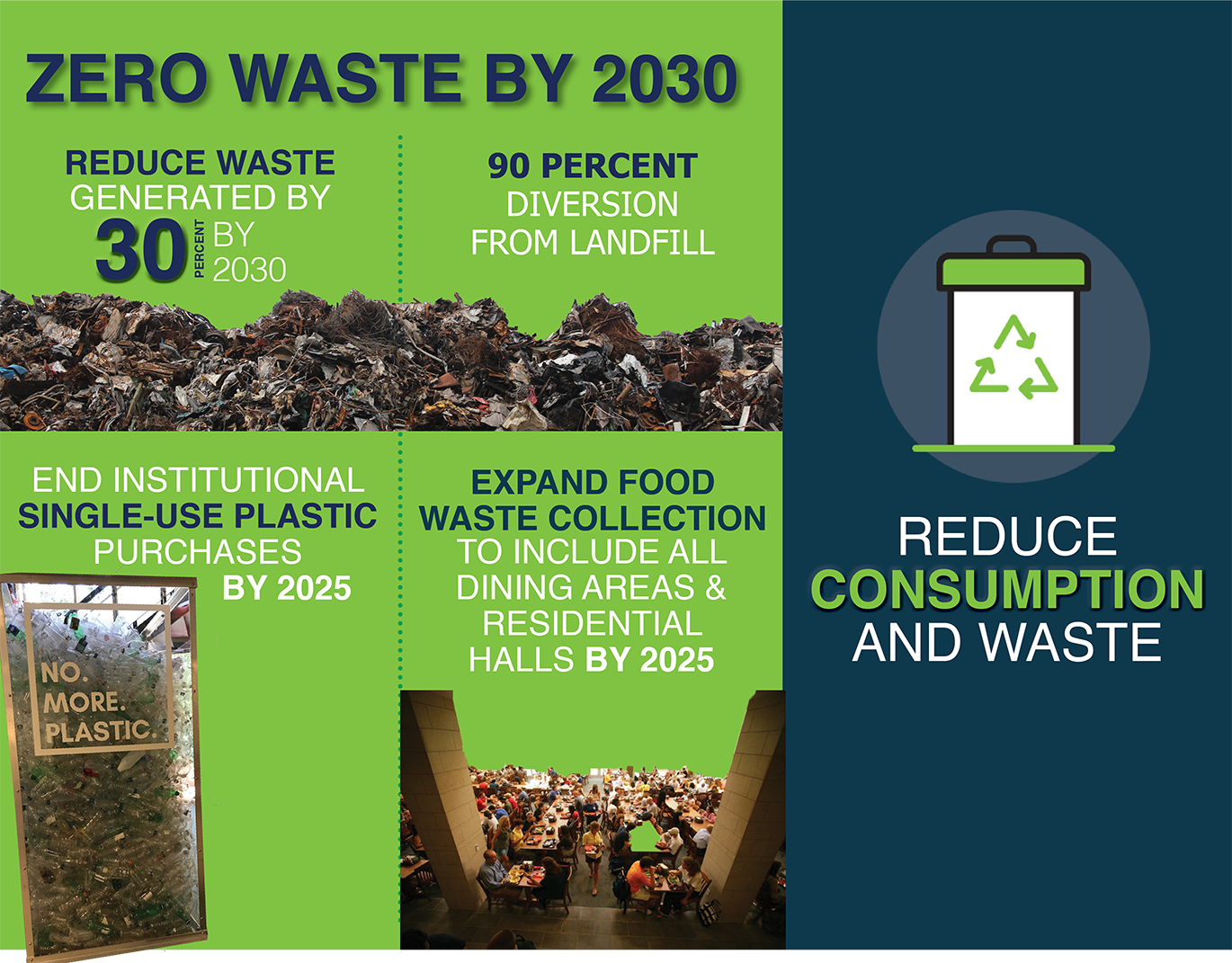
The Committee also examined current waste streams, waste generation activities, existing strategies, challenges and opportunities for improvement throughout campus. Data and feedback were gathered from almost 100 stakeholders through a series of meetings with various groups from across the university. The plan contains suggested paths for reducing or eliminating waste streams, increasing diversion rates with more recycling and food waste collection, and reusing or repurposing specific waste streams, as well as strategies for outreach and education.
Campus Waste and Recycling
Vanderbilt has a 30-year history of recycling efforts to reduce waste going to landfills. In addition to traditional recycling programs for materials such as paper, plastic, cardboard, and glass, Vanderbilt has recycling programs for non-traditional materials like construction and demolition debris, toner cartridges, batteries, light bulbs, scrap metal, and electronics. Additionally, the ReUse program that started in 2016 sustainably manages unneeded furniture and equipment owned by Vanderbilt University departments and laboratories. Vanderbilt has also made significant efforts to reduce waste from its dining facilities in the form of food waste reduction, and the reduction of waste from food service.
These efforts are creating major environmental impacts. Vanderbilt’s emissions related to waste and recycling were 37% higher from FY20-21 compared to FY19-20, and had a diversion rate for the University of 42.5% in FY20-21. During FY20-21, materials that contribute to waste and recycling, especially within dining facilities, were significantly shifted to accommodate safety precautions for COVID-19. This shift in operations resulted in the increase in emissions related to waste and recycling.
RECYCLING STREAMS
In FY20-21, Vanderbilt University generated 4,755 tons of waste and 3,519 tons of recycling. Waste disposal accounts for 3,274 MTCO2E from Vanderbilt or about 3% of our total emissions.
Vanderbilt’s 3,519 tons of recycling are broken down into specific streams below.
*TABLEAU 5*
Single Use Plastic
In line with Vanderbilt’s Zero Waste and single use plastic elimination goals sustainability efforts, Vanderbilt University no longer sells single-use plastic water and soda bottles in its dining facilities, markets and vending machines. This move aligns with Vanderbilt’s goal to eliminate single-use plastic purchases by 2025. The collaborative effort involved will reduce plastic waste by more than 430,000 plastic bottles per year and over 1.7 million bottles during a graduating class’s four-year experience. All undergraduate students were given a free, reusable water bottle and there are 150 hydration stations across campus. All to-go containers, cups, flatware, utensils, and napkins are compostable.
In 2020 Vanderbilt announced a new partnership with PepsiCo as the official beverage provider of the university in efforts to continue reducing waste. PepsiCo will provide the university with beverages packaged in either glass or aluminum to align with Vanderbilt Campus Dining’s “No More Plastic” campaign, while also providing a variety of drinks to account for student needs.
Commodore Concessions, a new partnership between Athletics and Campus Dining, joined the “No More Plastic” initiative at all Vanderbilt University athletics venues beginning in August 2021. The university ended the sale of all single-use plastic bottles, and as a result, fans now enjoy more sustainable beverage options at baseball, football, basketball, soccer, and lacrosse games. As an enhancement to the gameday experience, fans can purchase beer and water in recyclable, aluminum containers or reusable commemorative soft drink cups with unlimited Pepsi refills at self-service drink fountains. The impact of this shift has been significant, eliminating more than 25,000 single-use plastic bottles sold annually at Vanderbilt concessions stands. Additionally, recycling collection has been implemented at the Vanderbilt football stadium and will continue to be implemented at other sporting locations across campus.
Food Waste Reduction
MINIMIZING FOOD WASTE
Campus Dining has adopted two innovative systems to help reduce food waste. A cloud-based system, known as Fusion, offers a complete food and nutrition solution from menu planning to production, food service operations, purchasing and cost management, and student mobile nutrition information. The second system utilized is a technology called LeanPath. This system tracks all pre- and post-consumer waste as well as composted food waste and records the information in a cloud base system allowing for department wide analytics and waste analysis. LeanPath also helps avoid overbuying and reduce the need for unwanted food donation programs.
Unused food that remains is donated to local non-profits to be redistributed to the Nashville community.
Vanderbilt University Campus Dining recently collaborated with the James Beard Foundation, the Nashville Food Waste Initiative, and the Mayor’s Food Saver Challenge to host the “Waste-Not” cooking demonstration. Featuring local Nashville chef Julia Sullivan of Henrietta Red, the event highlighted cooking techniques that make use of ingredients that typically are considered food scraps or waste. By highlighting innovative ways to incorporate food scraps into restaurant-quality cooking, this event is intended to raise awareness of the problem of food waste—and of its many creative solutions. The demonstration is available to watch here.
COMPOST
A program for composting food waste was started in October 2017 in the Common’s Center Dining Hall. The program currently includes pre-consumer collection for all dining prep locations, as well as post-consumer collection at Rand dining hall and the Commons Center dining hall. Food waste is collected and composted by the Compost Company, a local vendor. In addition to food composting, all to-go food containers, cups, flatware, and straws offered are made from compostable materials.
Composting is a process in which organic waste is broken down into a rich, soil additive under controlled conditions. Compost can be used to promote plant growth while also reducing landfill waste by recycling organic materials back into the soil. The compost program has been expanded to include all dining locations and will be expanded in the future to support Vanderbilt’s Zero Waste Plan.
Sustainable Food Practices
Sustainable Dining
VU Campus Dining supports the well-being of diners and the health of our environment. Dining’s sustainability program is designed to give diners information about Vanderbilt’s kitchen principles and how they affect your environment, community and well-being. VU is also a member of the Menus of Change University Research Collaborative (MCURC). MCURC is a working group of leading scholars, foodservice business leaders, and executive chefs from invited universities who are accelerating efforts to move Americans toward healthier, more sustainable, plant-forward diets.
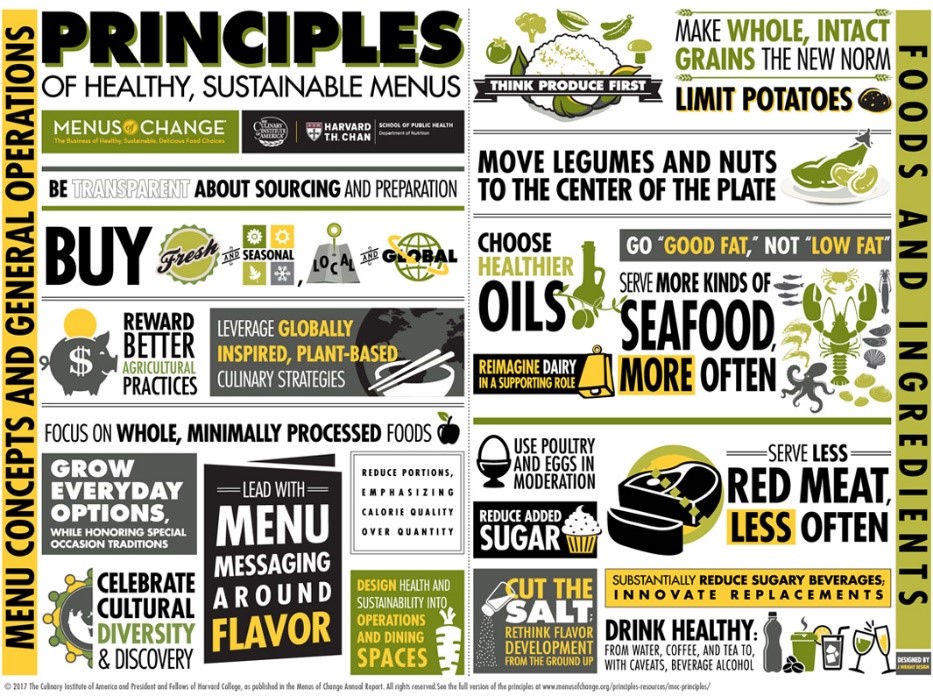
SUSTAINABLE PURCHASING
Vanderbilt is exploring a Sustainable Purchasing Policy that establishes standards for the purchase of goods and services consumed by the University with the goals of:
- Reducing the environmental footprint of the University’s operations
- Leveraging Vanderbilt University’s purchasing power to encourage transparency and environmentally friendly manufacturing practices within product industries
- Influencing generations of environmentally conscious product users through educational programs and by example
If two products are competitive in performance characteristics and pricing, the University will favor the environmentally preferable product or supplier. For example, Vanderbilt’s Purchasing and Payment Services has worked closely with the University’s preferred suppliers of office products, janitorial products, and laboratory products to provide more easily identified environmentally preferable product selections. These products are readily identifiable in Vanderbilt’s procurement system by a special symbol. Purchasing and Payment Services partners with suppliers that are committed to sustainability practices and offer the Vanderbilt community products like FSC recycled paper, remanufactured toner cartridges, and EnergyStar or EPEAT electronics.
The Sustainable Purchasing Policy will enable Vanderbilt to plan its future growth in balance with economic, environmental, and socially responsible values.
Invest in sustainable infrastructure
ENERGY – EFFICIENCY PROJECTS
Greenhouse gas emissions normalized on a square foot basis have dropped more than 37% since FY18-19 and 27% since FY19-20 due to a combination of ongoing energy efficiency improvements of existing buildings by Plant Operations, green building techniques employed in new construction by Campus Planning and Construction, increased efficiency in the NES electricity grid, and operational changes due to the COVID-19 pandemic. These building practices are described in the sections below.
LEED
Vanderbilt University was honored with a 2020 Leadership Award from the U.S. Green Building Council for the institution’s achievements in green building and its commitment to creating a healthy, sustainable future. The U.S. Green Building Council’s Leadership in Energy and Environmental Design rating system, known as LEED, has become the nationally accepted benchmark for the design, construction and operation of high-performance sustainable buildings. The council noted in its award announcement that Vanderbilt places a high priority on incorporating sustainability into the university’s construction and renovation projects.
Vanderbilt has a long history of building with sustainable and green features, which are more efficient and last longer. The U.S. Green Building Council’s Leadership in Energy and Environmental Design (LEED) Green Building Rating System is the nationally accepted benchmark for the design, construction, and operation of high-performance sustainable buildings. This third-party certification is recognized as confirmation that a building is environmentally responsible. LEED projects earn points across nine categories: integrative process, location and transportation, sustainable sites, water efficiency, energy and atmosphere, materials and resources, indoor environmental quality, innovation, and regional priority.
Vanderbilt University has a total of 24 LEED certified projects and was the first university in Tennessee to earn LEED certification.
Well
Looking forward, Vanderbilt will explore other certifications for sustainable buildings in addition to LEED. The School of Nursing building expansion is Vanderbilt’s first WELL certification pilot, in addition to achieving LEED Gold certification. WELL certification serves as a credible label for a building’s effect on occupants’ health and well-being.
Living Building Challenge
Vanderbilt is also exploring the Living Building Challenge certification, which certifies buildings that are regenerative and positively impact the environment. Vanderbilt’s first petal certification pilot is underway for the Peabody Home Economics and Mayborn Hall building complex, which is pursuing the materials petal. The intent of the Materials Petal is to help create a materials economy that is non-toxic, ecologically restorative, transparent, and socially equitable.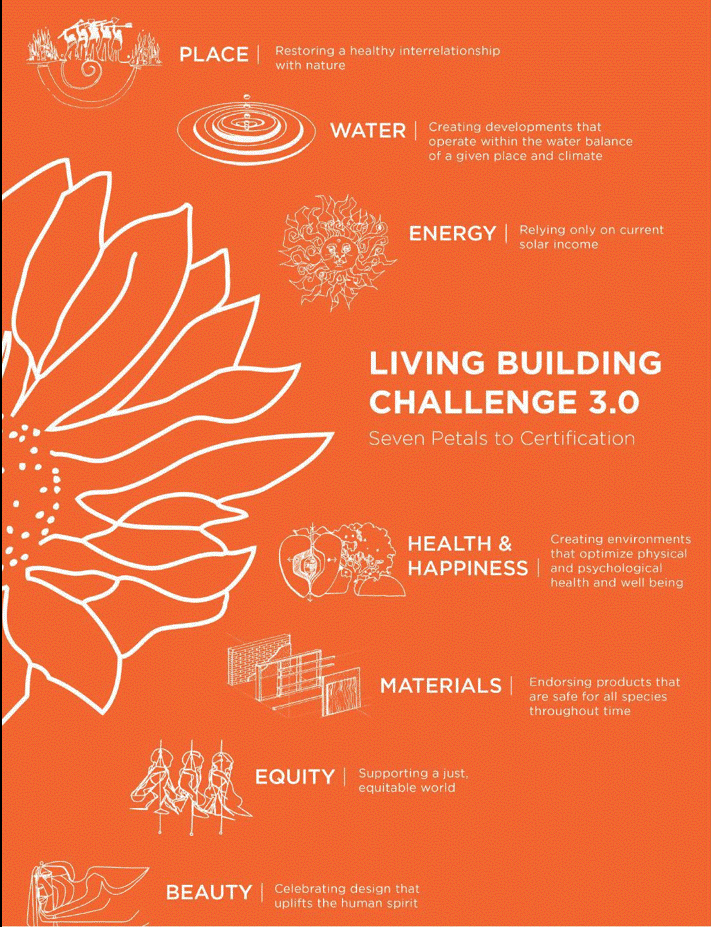
WATER
Vanderbilt has taken significant steps to reduce its water usage. Since 2007, Plant Operations has retrofitted 3,500 bathroom fixtures on campus in an effort to make them more water efficient. These efforts include low flow and no touch faucets, low flow and dual flush toilets, high-efficiency showerheads and water free urinals.
*TABLEAU 6*
Green Cleaning
Vanderbilt is expanding the use of green cleaning products and practices throughout VU Facilities as part of its focus on WELL building principles. VU is implementing a Green Cleaning Policy requiring:
- Each building to have an individualized Green Cleaning Plan
- Campus green cleaning practices to be tracked
- The use of pre-approved green cleaning products and equipment
- Routinely providing education on best practices, new technologies, and procedures for green cleaning
- Policy revisions every five years
ENGAGEMENT AND EDUCATION
FutureVU Sustainability acts as the sustainability information hub for Vanderbilt University. Together with the FutureVU Sustainability website, newsletter, social media, and in-person education and training, FutureVU Sustainability has had the following engagement impact:
Green Fund
The Vanderbilt Green Fund (VGF) provides funding specifically to projects that are student-initiated and reduce the greenhouse gas emissions or improve the overall sustainability of the Vanderbilt University campus. VGF enables students, faculty, and administration to directly engage in the process of transitioning to a clean and sustainable energy future. Any student, faculty, or group associated with Vanderbilt University can propose a project for consideration.
The Office of Housing and Residential Education and Plant Operations make a combined annual input of $150,000 to the VGF. Green Fund proposals are first evaluated by a student committee that is organized jointly by VSG and SPEAR. Top proposals are recommended by the student committee to the Green Fund Working Group, which makes the final funding decisions. The Working Group is comprised of six administrators, six students, and one faculty member.
PAST REPORTS
Vanderbilt is committed to the highest standards of transparency and sustainability through a process of environmental responsibility and accountability at every level of the University. With regards to climate change, this commitment translates to actions aimed at reducing greenhouse gas (GHG) emissions at the university, departmental, and individual level.
The completion of a university-wide GHG emissions inventory has occurred annually since the first publication in 2005. These reports provide many key data points, past trends and successes of Vanderbilt University and its efforts to curb greenhouse gas emissions and operations.
The listing to the right provides downloadable files of our past greenhouse gas inventories and reports.
From 2008 to 2015, Vanderbilt University, including Vanderbilt University Medical Center, reduced its overall greenhouse gas emissions by 27%. In 2016, the University separated from the Medical Center, resulting in changes to its boundaries, operations, and size of population, which necessitated a new 2016 baseline.
- FY 2019-2020 Annual Sustainability Report
- FY 2018-2019 Annual Sustainability Report
- FY 2017-2018 Annual Sustainability Report
- 2016 Annual Sustainability Report
- 2015 Greenhouse Gas Emissions Inventory Update,
Published October 2016 - 2014 Greenhouse Gas Emissions Inventory Update,
Published October 2015 - 2013 Greenhouse Gas Emissions Inventory Update,
Published October 2014 - 2012 Greenhouse Gas Emissions Inventory Update,
Published October 2013 - 2011 Greenhouse Gas Emissions Inventory Update,
Published October 2012 - 2010 Greenhouse Gas Emissions Inventory Update,
Published October 2011 - 2005-2009 Greenhouse Gas Emissions Inventory Update,
Published October 2010 - 2005-2007 Original Greenhouse Gas Emissions Inventory
Contact
Andrea George, PhD, BCES, CHMM, PMP
Assistant Vice Chancellor, Environmental Health, Safety and Sustainability
Email: andrea.george@vanderbilt.edu
Steve Gild, MS, CHMM
EMS Coordinator, Senior Safety Officer
Email: steve.gild@vanderbilt.edu
Chelsea Hamilton, MS, LEED AP
Sustainability Outreach Program Manager
Email: chelsea.l.hamilton@vanderbilt.edu
Sustainability program contact
Email: futurevusustainability@vanderbilt.edu

